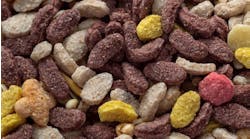Food product contamination scares resonate as much with pet “parents” as with human ones, for much the same reason: They target a vulnerable object of great affection, who usually can’t tell you how they’re suffering.
And their population increased during the pandemic. According to one estimate, 12.6 million American households adopted a new pet during the pandemic. The pet food market is estimated at $96.9 billion for 2020 and is forecast to grow at up to 5% a year for the immediate future, according to Technavio.
As pets proliferate, so does the attention paid to their safety. There have been eight FDA pet food recalls so far in 2021 (as of press time), with 43 listed in 2020. These include some high-profile ones like Midwestern Pet Foods, which went through two recalls of dry dog food this year, the first of them a mold toxin contamination that was implicated in the deaths of at least 110 dogs and led to at least one lawsuit.
“Just like pet owners, safety is top of mind for pet food makers, and it is our No. 1 priority,” says Pat Tovey, director of technology and regulatory compliance for the Pet Food Institute, a trade group for pet food manufacturers.
“America’s dog and cat food makers [recognize] pets are important members of the household," Tovey continues. "They recognize the invaluable physical and mental benefits of the human-animal bond, and know the increasing role pets played in providing companionship during the pandemic. It is critical to provide safe food for our dogs and cats.”
The industry’s general approach is that pet food should abide by the same safety standards as human food, Tovey says. When the Food Safety and Modernization Act passed in 2011, it included a section on hazard analysis and preventive controls for animal food. Basically, to be FDA-certified, a pet food processing facility “must identify and implement preventive controls to provide assurances that any hazards requiring a preventive control will be significantly minimized or prevented,” just as a regular food plant does.
The first step in practical application of these principles is identification of microbiological kill steps. For canned food, it’s simple: retorting, which always serves as a backstop. The reliability of retorting as a safety measure probably accounts for why, of the FDA’s 43 animal food recalls in 2020, only three involved canned food.
How dry we are
However, only a small portion of the pet food sold in America comes in cans. Dry food is far more common, accounting for more than 70% of U.S. sales. And dry food is more common in recalls, accounting for 21 last year (and five of the eight so far this year).
Without the backstop of retorting or any kind of in-package treatment, dry food like kibble represents a bigger challenge with microbiological safety. Its low water activity helps – but that advantage can get wiped out if the kibble is mixed with water before consumption.
Extrusion, a popular processing method for many kinds of dry pet food, can serve as a kill step under proper conditions. Photo: Clextral
“Pathogenic bacteria and their spores can survive indefinitely in dry flour and replicate with increased water activity,” says José Coelho, Americas business director for extruder-maker Clextral.
Thermal kill steps for dry pet food have to be applied during processing instead of after packaging. Cooking is the obvious place to start, if that’s part of the formulation. Some techniques, like steam injection, allow for the precise temperature control required for a kill step.
Hydro-Thermal offers steam-heating options either as individual pieces of equipment or turnkey systems. These can heat something like a meat slurry for dog food to within one degree Fahrenheit, says vice president of sales Sean Fulton.
Kibble and other forms of dry pet food are often extruded, which presents several options for thermal treatment. Product can be heated through steam injected into the extruder barrel; through steam, hot water or thermal fluid that exchanges heat through a jacketed barrel; or simply through friction that generates heat as the extruder works the product. In addition, extrusion can rupture certain microorganisms that survive heat treatment, Coelho says.
“Clextral extruders for pet food applications process at the required temperatures, pressures and shear (which can disrupt the cell structure of heat-resistant microorganisms) to be certified as kill step processes,” he says.
For extrusion to be a reliable kill step, parameters like feed rate and screw speed have to be set correctly. These in turn will depend on the product’s initial moisture, viscosity and other factors – which may also dictate the choice of extruder. According to Clextral, high-moisture products need a twin-screw extruder if extrusion is to be a kill step, because of the extra pumping action required.
Toxin troubles
Microorganisms can threaten indirectly as well as directly, through production of lethal toxins like aflatoxin and mycotoxin generated by mold contamination of grains. This kind of contamination caused the first Midwestern Pet Foods outbreak.
Microbiological analytical techniques long used on human food are migrating to pet food processing. Photo: Neogen
Toxin incidents are especially worrisome because they can be hard to detect, much less bring under control. The problem starts with the mold that generates toxins. Conventional microorganisms are detectable either because they’re present in sufficiently large numbers in a sample, or they can be grown in a lab from that sample. That usually isn’t the case with the mold that creates toxins, which can be present in a small, remote area of a mound of grain. That’s why defense against mold-based toxins starts with a thorough inspection of incoming ingredients, says Joe Heinzelmann, director of business development at Neogen.
“You have to use statistics and a good sampling plan to say, ‘Based on my sampling plan, I have a high enough confidence that my program is going to detect if there’s an issue,’” Heinzelmann says.
It’s best to inspect incoming ingredients if aflatoxin is a concern and not rely on tests of finished products.
“Before that truck [contents] gets put into the big bin, you’re verifying that that truck does not have that toxin,” Heinzlemann says. “It’s more efficient from an operational and resource-management [standpoint] to test the incoming stuff than it is after you’ve done all the work to it.”
Detecting the toxins themselves can be as tricky as finding the mold that generates them. Neogen uses an ELISA (enzyme-linked immunosorbent assay) test, the same kind used to search for pathogens by detecting their antigens.
Sciex offers equipment that uses liquid chromatography tandem mass spectroscopy (LC-MS/MS), which can search for a variety of substances, including toxins. It’s easier to use than the more common alternative, gas chromatography-mass spectrometry.
“I’ve personally trained a lab manager at a pet food company to set up a mycotoxin method” with LC-MS/MS equipment, says Rob Di Lorenzo, food and beverage staff scientist at Sciex. He says LC-MS/MS can look for very low quantities of toxins like mycotoxins and pesticides, as well as desirable components like vitamins and flavonoids.
Upscale alternatives
Dry and canned pet food dominate the market, but alternatives that are coming on strong include frozen and refrigerated products – usually upscale ones. These present their own microbiological challenges, especially if they contain raw protein – an increasingly popular choice.
One option for such products is high-pressure processing (HPP), which destroys microorganisms without heat. It works by immersing flexible packaging in a tank with water pressurized at 87,000 psi or more; the pressure, transmitted through the packaging, inactivates microorganisms by literally squeezing them to death.
Steve’s Real Food processes pet food with raw ingredients including meat, fruits, vegetables and goat milk. It uses HPP to treat incoming proteins, which it receives in chub form, suitable for immersion. More recently, it has begun using HPP to treat freeze-dried ingredients.
“We did this to allow us to enter some new international markets and to streamline the processing,” says company CEO Nicole Lindsley.
As pet food recalls and tragedies related to tainted food resound in the news, product safety becomes ever more of a concern to pet owners. Processors can ensure safety by applying the same standards and expectations to pet food as to human food.


